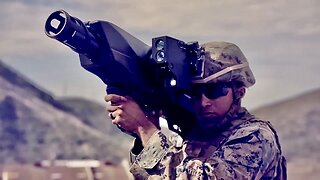Premium Only Content

NASA's Hunt For Exo-Planets - The Technology They Use
NASA Puts Next-Gen Exoplanet-Imaging Technology to the Test - A cutting-edge tool to view planets outside our solar system has passed two key tests ahead of its launch as part of the agency’s Roman Space Telescope by 2027. The Coronagraph Instrument on NASA’s Nancy Grace Roman Space Telescope will demonstrate new technologies that could vastly increase the number of planets outside our solar system (exoplanets) that scientists can directly observe. Designed and built at the agency’s Jet Propulsion Laboratory in Southern California, it recently passed a series of critical tests ahead of launch. That includes tests to ensure the instrument’s electrical components don’t interfere with those on the rest of the observatory and vice versa.
“This is such an important and nerve-wracking stage of building a spacecraft instrument, testing whether or not everything works as intended,” said Feng Zhao, deputy project manager for the Roman Coronagraph at JPL. “But we have an amazing team who built this thing, and it passed the electrical components tests with flying colors.”
A coronagraph blocks light from a bright cosmic object, like a star, so that scientists can observe a nearby object that would otherwise be hidden by the glare. (Think of a car’s sun visor.) The light reflected or emitted by a planet carries information about the chemicals in the planet’s atmosphere and other potential signs of habitability, so coronagraphs will likely be a critical tool in the search for life beyond our solar system.
But if scientists were trying to obtain images of an Earth-like planet in another solar system (same size, same distance from a star similar to our Sun), they wouldn’t be able to see the planet in the star’s glare, even with the best coronagraphs and most powerful telescopes operating today.
The Roman Coronagraph aims to change that paradigm. The innovations that have gone into the instrument should make it possible to see planets similar to Jupiter in size and distance from their star. The Coronagraph team expects these advances will help enable the leap to viewing more Earth-like planets with future observatories.
As a technology demonstration, the Roman Coronagraph’s primary goal is to test technologies that have not been flown in space before. Specifically, it will test sophisticated light-blocking capabilities that are at least 10 times better than what’s currently available. Scientists expect to push its performance even further to observe challenging targets that could yield novel scientific discoveries.
Even with the Coronagraph blocking a star’s light, a planet will still be exceptionally faint, and it might take a full month of observations to get a good picture of the distant world. To make these observations, the instrument’s camera detects individual photons, or single particles of light, making it far more sensitive than previous coronagraphs.
That’s one reason the recent tests were crucial: The electrical currents that send power to the spacecraft’s components can produce faint electrical signals, mimicking light in the Coronagraph’s sensitive cameras – an effect known as electromagnetic interference. Meanwhile, signals from the Coronagraph could similarly disrupt Roman’s other instruments.
The mission needs to ensure neither will happen when the telescope is operating in an isolated, electromagnetically quiet environment 1 million miles (about 1.5 million kilometers) from Earth. So a team of engineers put the fully assembled instrument in a special isolated, electromagnetically quiet chamber at JPL and turned it on to full power.
They measured the instrument’s electromagnetic output to make sure it fell below the level required to operate aboard Roman. The team used injection clamps, transformers, and antennas to produce electrical disturbances and radio waves similar to what the rest of the telescope will generate. Then they measured the instrument’s performance, looking for excessive noise in the camera images and other unwanted responses from the optical mechanisms.
“The electric fields we generate with the antennas are about the same strength as what’s generated by a computer screen,” said Clement Gaidon, the Roman Coronagraph electrical systems engineer at JPL. “That’s a pretty benign level, all things considered, but we have very sensitive hardware onboard. Overall, the instrument did a fantastic job navigating across the electromagnetic waves. And props to the team for wrapping this test campaign in record time!”
#explore #space #universe
-
 49:45
49:45
Knowledge Land
10 months agoFuture War Technology - Armies of Tomorrow
394 -
 14:13
14:13
Scammer Payback
12 days agoTelling Scammers Their Address
108K77 -
 5:43:21
5:43:21
Barstool Gambling
9 hours agoBig Cat and Co Sweat Out the Week 10 Sunday Slate | Barstool Gambling Cave
79.6K3 -
 2:49:36
2:49:36
The Jimmy Dore Show
2 days agoRumble Time Live w/ Jimmy Dore & Special Guests Roseanne Barr, Dr. Drew, Drea de Matteo & More!
546K653 -
 17:17
17:17
DeVory Darkins
22 hours agoKamala Post-Election BOMBSHELL Exposes $1 BILLION Campaign DISASTER
75K152 -
 19:52
19:52
Stephen Gardner
1 day ago🔥HOLY CRAP! Trump just did the UNTHINKABLE!!
79.4K526 -
 4:34:55
4:34:55
Pepkilla
9 hours agoBlackops Terminus Zombies Boat Glitch
139K6 -
 5:50
5:50
CapEx
22 hours ago $24.35 earnedWhat the Coming & Inevitable Sovereign Debt Crisis Means for YOU | CapEx Insider
127K28 -
 1:34:00
1:34:00
Tactical Advisor
10 hours agoAR15 Giveaway WINNER/Trump Winning | Vault Room Live Stream 008
88.3K40 -
 5:41:10
5:41:10
Vigilant News Network
12 hours agoOfficials CAUGHT Changing Ballots in Arizona | The Daily Dose
137K84